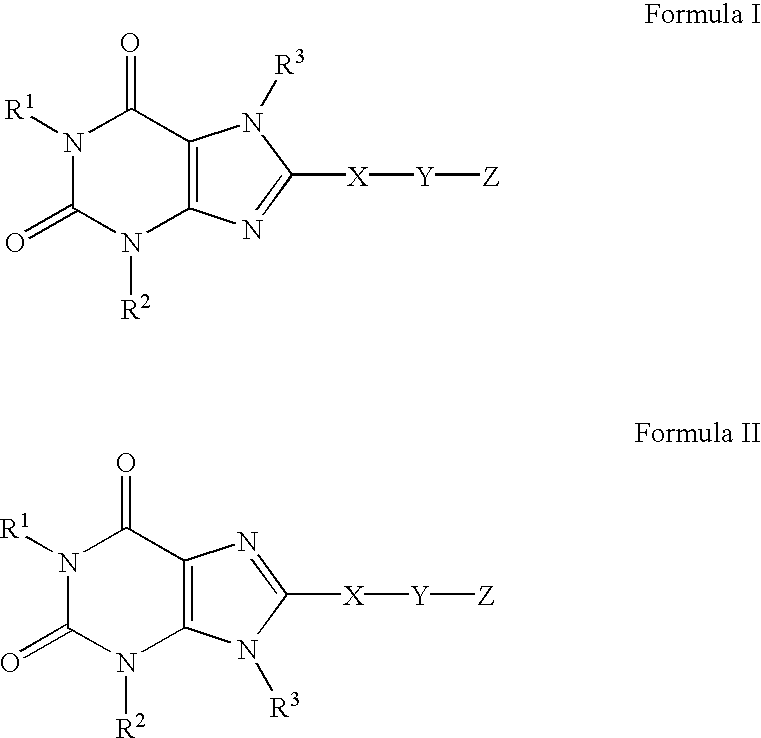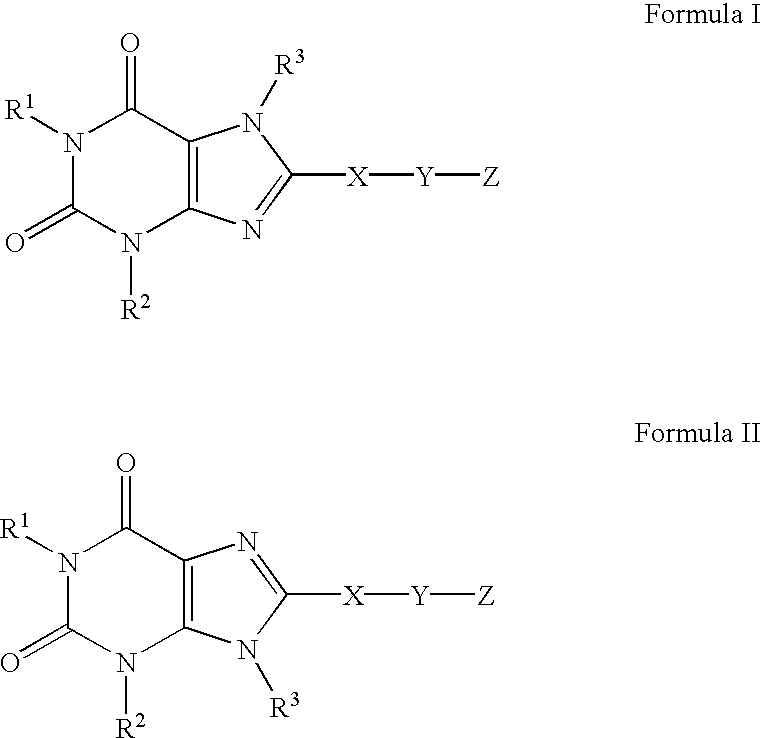A2B adenosine receptor antagonists
a technology of adenosine receptor and adenosine, which is applied in the direction of biocide, heterocyclic compound active ingredients, drug compositions, etc., can solve the problems of large plasma levels, potentially fatal complications, and unfavorable blood vessel increase, and achieve the effect of preventing the action of microorganisms
- Summary
- Abstract
- Description
- Claims
- Application Information
AI Technical Summary
Benefits of technology
Problems solved by technology
Method used
Image
Examples
example 2
Preparation of a Compound of Formula (3)
[0235]A. Preparation of a Compound of Formula (3) where R1 and R2 are Both n-Propyl
[0236]7-Benzyl-1,3-dipropyl-1,3,7-trihydropurine-2,6-dione, a compound of formula (2), (2.0 g, 6.1 mmole) and N-chlorosuccinimide (1.0 g, 7.4 mmole) were combined in 100 mL of tetrahydrofuran and stirred at room temperature for 4 hours. The solvent was removed under reduced pressure, and the residue dissolved in ethyl acetate. The solution was washed with water, then brine, and dried over magnesium sulfate. The solvent was removed under vacuum, to afford a compound of formula (3) where R1 and R2 are both n-propyl, 7-benzyl-8-chloro-1,3-dipropyl-1,3,7-trihydropurine-2,6-dione, which was recrystallized from ethyl acetate / hexane (1:50).
B. Preparation of a Compound of Formula (3), Varying R1 and R2
[0237]Similarly, following the procedure of 2A above, but replacing 7-benzyl-1,3-dipropyl-1,3,7-trihydropurine-2,6-dione by other compounds of formula (2), the following...
example 3
Preparation of a Compound of Formula (4)
[0252]A. Preparation of a Compound of Formula (4) where R1 and R2 are Both n-Propyl, X is Phenyl, and L is —O—
[0253]7-Benzyl-8-chloro-1,3-dipropyl-1,3,7-trihydropurine-2,6-dione, a compound of formula (3) where R1 and R2 are both n-propyl (5.0 g, 14 mmoles), and 4-hydroxyphenyl-boronic acid (2.0 g, 14 mmoles) were dissolved in 100 ml of a mixture of toluene / ethanol (4:1) and stirred at reflux for 16 hours. Solvent was removed under reduced pressure, and the residue was chromatographed over a silica gel column, eluting with ethyl acetate:hexane (1:4) to give a compound of formula (4) where R1 and R2 are both n-propyl, X is phenyl, and L is —O-(7-benzyl-8-(4-hydroxyphenyl)-1,3-dipropyl-1,3,7-trihydropurine-2,6-dione), as a pale yellow solid.
B. Preparation of a Compound of Formula (4), Varying R1, R2, X and L
[0254]Similarly, following the procedure of 3A above, replacing 7-benzyl-8-chloro-1,3-dipropyl-1,3,7-trihydropurine-2,6-dione with other com...
example 4
Preparation of a Compound of Formula (5)
[0269]A. Preparation of a Compound of Formula (5) where R1 and R2 are Both n-Propyl, X is Phenyl, and L is —O—
[0270]The compound of formula (4) where R1 and R2 are both n-propyl, X is phenyl, and L is —O-(7-benzyl-8-(4-hydroxyphenyl)-1,3-dipropyl-1,3,7-trihydropurine-2,6-dione) (613 mg) was dissolved in methanol (50 ml), a catalytic amount of palladium hydroxide added, and the mixture stirred under hydrogen at room temperature overnight. The mixture was filtered, washing the catalyst with methanol, and the solvent was evaporated from the filtrate under reduced pressure to provide. 8-(4-hydroxyphenyl)-1,3-dipropyl-1,3,7-trihydropurine.
[0271]This product was dissolved in methanol, di-tert-butyldicarbonate (0.7 g, 3.2 mmol) and N,N-di-isopropylethylamine (1 ml) added, and the mixture refluxed overnight. The solvent was removed under reduced pressure, and the residue chromatographed on a silica gel column, to give a compound of formula (5), 7-t-bu...
PUM
| Property | Measurement | Unit |
|---|---|---|
| Volume | aaaaa | aaaaa |
| Mass | aaaaa | aaaaa |
| Fraction | aaaaa | aaaaa |
Abstract
Description
Claims
Application Information
 Login to View More
Login to View More - R&D
- Intellectual Property
- Life Sciences
- Materials
- Tech Scout
- Unparalleled Data Quality
- Higher Quality Content
- 60% Fewer Hallucinations
Browse by: Latest US Patents, China's latest patents, Technical Efficacy Thesaurus, Application Domain, Technology Topic, Popular Technical Reports.
© 2025 PatSnap. All rights reserved.Legal|Privacy policy|Modern Slavery Act Transparency Statement|Sitemap|About US| Contact US: help@patsnap.com



